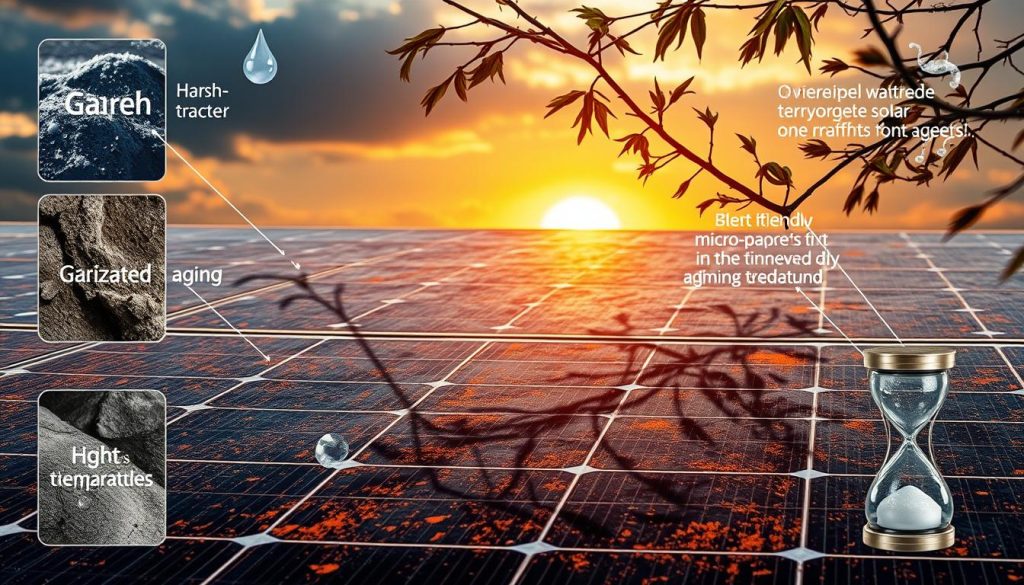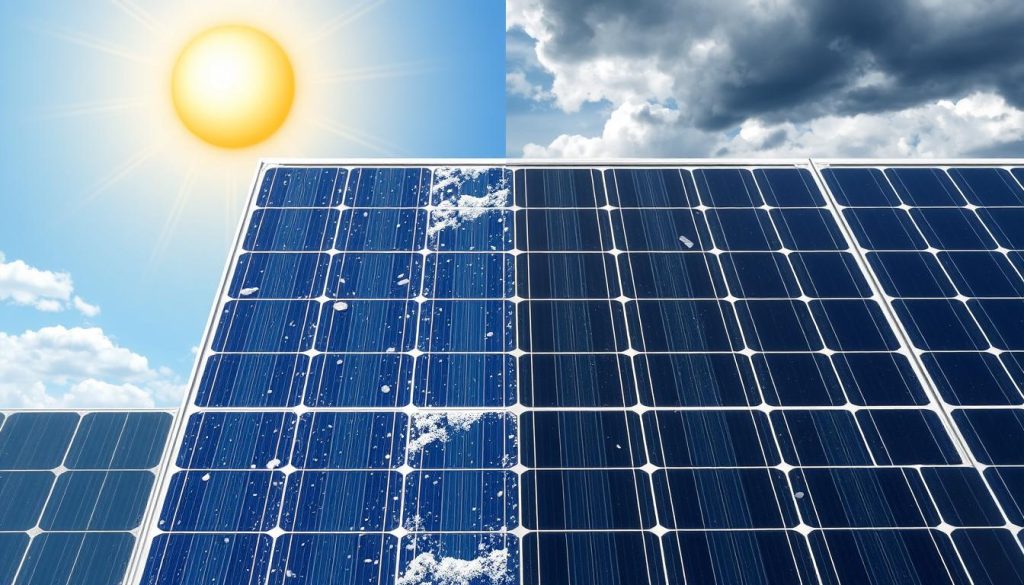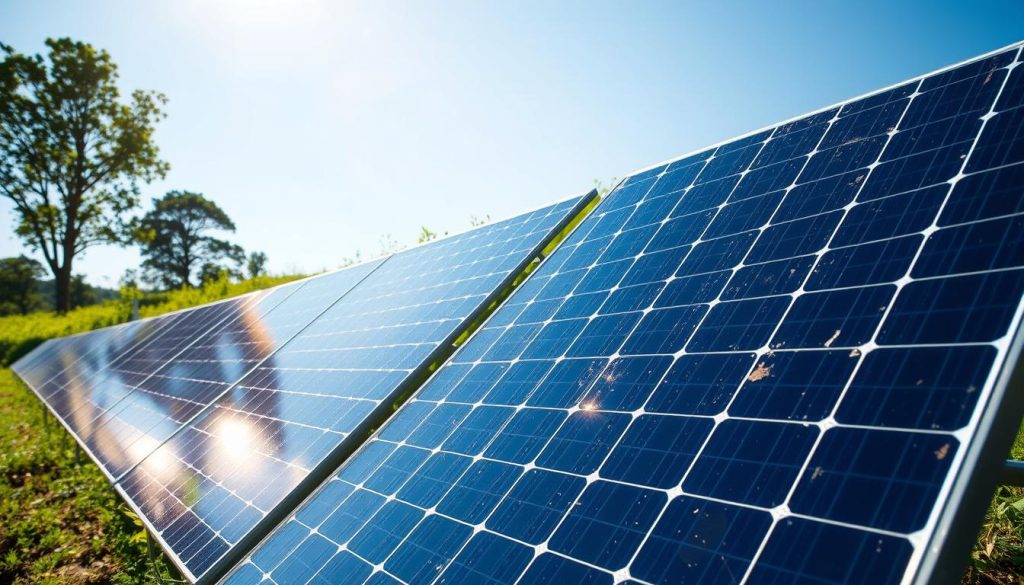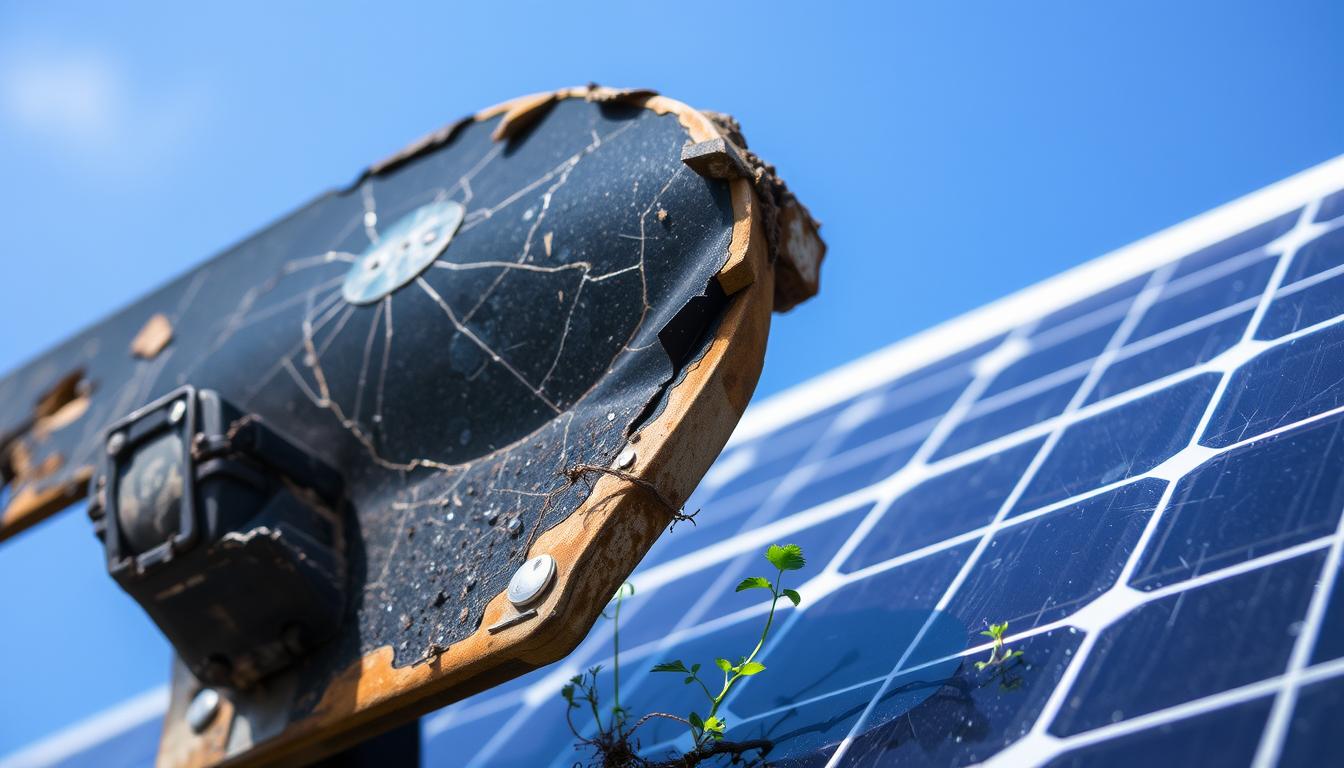Have you considered how the efficiency of solar panels may diminish as time passes? Is it still a worthwhile investment? Solar energy installations are significant for those exploring renewable resources. Recognizing the implications of solar panel degradation is essential. Solar panels are engineered to endure for 25 to 30 years; however, factors such as wear and environmental conditions play a crucial role. This article explores everything concerning solar panel degradation. It assists owners in maintaining their solar systems effectively for extended periods.
Main Points
- Solar panels generally have a lifespan of 25 to 30 years, operating at approximately 80% efficiency after this time frame.
- Producers assure 90% output for the initial ten years, followed by a decrease to 80% over the subsequent 15 to 20 years.
- The typical deterioration rate of solar panels is about 1% annually.
- High-grade solar panels manufactured after the year 2000 deteriorate at just 0.4% per year.
- Little upkeep is needed due to the robust nature of solar panels and their absence of moving components.
- Recycling data indicates that as much as 95% of solar panel glass and 85% of silicon content can be recovered.
Overview of Solar Panel Degradation
Solar panel degradation affects the durability and performance of solar energy systems. It results in a gradual decline in solar panel efficiency as time progresses. This decline is due to environmental influences and the limits of the materials utilized. Solar panels diminish in strength from exposure to the elements.
Solar panels come with a manufacturer warranty lasting 25 to 30 years. They are anticipated to function effectively beyond this timeline. Nonetheless, it is vital to understand that solar panel degradation signifies that panels will inevitably undergo wear and tear. This deterioration impacts their capacity to generate energy. On average, numerous panels lose around 1% of their energy-producing capability each year.
A variety of elements contribute to the ageing of solar panels. Microcracks frequently develop due to fluctuations in temperature. This can reduce the energy output of the panels. Furthermore, solar panel discoloration occurs as a result of EVA browning. This diminishes the panel’s ability to manage UV radiation. Awareness of these challenges is crucial for anyone investing in solar technology.
What is Solar Panel Degradation?
Solar panel degradation refers to the gradual reduction of energy output over time. This process is influenced by issues such as microcracks and prolonged exposure to sunlight. These challenges hinder the panels from operating at their optimal performance. On average, they lose about 1% of their efficiency each year. Over time, panels may lose as much as 20% of their original output. Subsequently, they may no longer be safe or effective for use.
Most modern solar panels are expected to remain functional for around 30 years. However, researchers are striving to extend this lifespan, potentially up to 50 years. Organizations like the DuraMAT Consortium are instrumental in this effort. Their aim is to develop new testing and evaluation methods that enhance the durability of solar panels. These methodologies assist in comprehending the reliability of solar technology.
Understanding solar panel degradation is vital for homeowners and business operators. It enables them to manage their solar energy sources effectively. Acknowledging that panels may become less efficient over time fosters the development of improved maintenance strategies. With proper care, solar panels can function optimally for as long as possible.
| Aspect | Details |
|---|---|
| Average Degradation Rate | 0.5% to 1% annually |
| Output Loss Before Failure | About 20% |
| Expected Lifespan | 30 years (potentially extending to 50 years with ongoing research) |
| Annual Solar Capacity Increase | 21% anticipated from 2023 to 2027 |
| Volume of Solar Panel Waste by the 2050s | At least 5 million metric tons each year |
Factors Affecting Solar Panel Ageing
To prolong the functionality of solar panels, it is crucial to understand what leads to their deterioration. There are numerous factors that influence how quickly solar panels age.
- Material Quality: The lifespan of solar panels significantly depends on the quality of the materials used in their production. High-quality components result in slower degradation for the panels.
- Installation Practices: Proper installation of panels is essential. Poor installation can damage them or create vulnerabilities, accelerating their ageing process.
- Environmental Conditions: The location of the panels can influence their longevity. For instance, panels situated near coastal areas may corrode due to salty air, while those in hotter regions may deteriorate quicker due to heat.
- Maintenance: Routine cleaning and maintenance help prevent dirt buildup that can obstruct sunlight, thereby reducing output.
- Temperature Fluctuations: Variations in temperature impact PV panels. For every degree Celsius increase, efficiency can decrease by roughly 0.5%.
Here is a table summarizing the key factors influencing solar panel degradation:
| Factor | Impact on Ageing |
|---|---|
| Material Quality | Higher quality components lead to diminished wear over time. |
| Installation Techniques | Poor installation practices can result in accelerated panel deterioration. |
| Environmental Exposure | Panels in coastal regions may rust; heat can affect panels in warm climates. |
| Maintenance Routine | Regular maintenance keeps panels clean, enhancing their effectiveness. |
| Temperature Variations | Increased temperatures can lead to efficiency loss in solar panels. |
Understanding these factors enables solar panel owners to make informed decisions. This knowledge can help protect their panels from premature degradation, extending their operational lifespan.

The Degradation Process: Understanding Solar Panel Ageing
Comprehending how solar panels age is crucial for ensuring their effective operation. Numerous factors contribute to the decline in their efficiency over time, impacting your investment. By grasping these challenges, we can care for our solar panels with greater effectiveness.
Microcracks and Thermal Cycling
Microcracks occur in solar cells as a result of temperature shifts. This stress gives rise to minute fractures. These fractures hinder the amount of light the cells can absorb and allow moisture to penetrate. This situation accelerates the rate at which solar panels deteriorate. Conducting regular inspections can identify these issues early, facilitating timely repairs.
Effects of Sunlight: Light-Induced Degradation
When solar panels are first exposed to sunlight, they may lose some efficiency, known as light-induced degradation (LID). This temporary decline is vital to acknowledge. It aids in forecasting the panels’ performance, which is crucial for managing energy agreements.
Potential Induced Degradation (PID)
Potential induced degradation (PID) poses a significant challenge for solar panel efficiency. It occurs in systems with varying voltage levels and can lead to substantial performance losses. Monitoring your system is essential to mitigate losses and avoid contractual issues due to inadequate performance.
Impact of Environmental Conditions on Solar Panel Ageing
Environmental factors significantly affect how solar panels age. Issues such as fluctuations in moisture, temperature, and chemical exposure can influence their efficiency and longevity. Being aware of these factors facilitates better decision-making in maintaining solar energy systems.
Effect of Water and Moisture Levels
An excess of water and moisture can accelerate the degradation of solar panels. Frequent exposure to wet conditions leads to corrosion, which damages the materials of the panels. This corrosion can result in diminished efficiency and may lead to failure, negatively impacting their overall performance.
EffectRegarding Temperature Variations
Solar panels situated in warm areas encounter a significant challenge due to temperature variations. Research indicates that these panels experience approximately 0.88% loss in their efficiency annually. This is twice the loss observed in panels located in cooler regions, which have a yearly performance decline of around 0.48%. Variations in temperature can lead to minor cracks, accelerating the aging process of the panels.
Effect of Chemical Exposure
When solar panels are exposed to harsh chemicals, whether from pollution or unsuitable cleaning agents, their performance can deteriorate. These substances can degrade the materials, hastening the aging process. Over time, this can result in a substantial reduction in the panels’ efficiency. Therefore, it is essential for owners to monitor their systems closely.

| Environmental Factor | Effect on Solar Panel Aging | Yearly Performance Decline (%) |
|---|---|---|
| High Humidity Levels | Corrosion and material deterioration | Varies |
| Temperature Variations | Microcracking and thermal stress | 0.88% (hot), 0.48% (cool) |
| Chemical Exposure | Material deterioration | Varies |
Solar Panel Longevity: Anticipations
Solar panels generally last around 25 to 30 years. As time progresses, their efficiency gradually decreases, with an annual reduction of approximately 0.5%. Even after 25 years, they can maintain about 89% of their original output. High-caliber solar panels, such as Tier One options, often perform effectively for an extended period, frequently surpassing their warranty commitments.
It’s crucial for purchasers to evaluate how solar panel efficiency might influence their finances. Most warranties span 25 years. Following that period, the systems may experience a significant decrease in power output. When energy production diminishes by about 20%, it signifies that they fail to meet energy demands adequately.

Organizations such as the Durable Module Materials (DuraMAT) Consortium are striving to extend the lifespan of solar panels up to 50 years. They explore how innovative materials and designs withstand various stresses. This research enhances manufacturers’ understanding of creating more durable solar panels. This knowledge can enhance the long-term value of solar energy investments.
For solar panels to continue to function effectively, they require consistent maintenance. This ensures extended electricity generation, proving a wise financial investment. Preparing for eventual replacements can also lead to savings on energy costs over time.
| Type | Expected Lifespan (Years) | Efficiency After 25 Years (%) | Degradation Rate (% Per Year) |
|---|---|---|---|
| Standard Panels | 25-30 | 89 | 0.5 |
| Tier One Panels | 25-30+ | 90-85 | 0.3 |
| Tier Two Panels | 25-30 | 88-80 | 0.5 |
| Tier Three Panels | 25-30 | 85-75 | 0.8 |
Solar Panel Upkeep and Attention
Properly maintaining your solar panels is essential for their extended life and peak efficiency. Simple tasks like cleaning and inspections significantly enhance the efficiency of solar energy systems. It’s vital to recognize that even minor maintenance efforts can greatly influence performance. Thus, keeping up with maintenance is critical for both residential and commercial owners.
Regular Cleaning and Maintenance Procedures
Cleaning your solar panels at least biannually is crucial for maximizing energy collection. Dirt and debris obstruct sunlight, reducing the energy harvest. Experts recommend a comprehensive inspection and cleaning every five years, or more frequently if dirt accumulation is significant or special conditions exist. Cleaning might seem minor but is vital to prevent a yearly decrease in efficiency of 0.8% due to grime.
Annual inspections typically cost between $150 and $300, but they are worthwhile for budget-friendly upkeep. Documenting all maintenance and repairs is highly beneficial for resolving potential future issues and tracking performance. It’s also prudent to monitor for signs of reduced energy output, damage, and inverter complications. These indicators may necessitate prompt intervention to address issues.
Choosing the Appropriate Installer
Selecting the right installer is crucial for the performance and longevity of your solar panels. Opt for certified professionals with extensive experience. This decision impacts both the initial installation and subsequent maintenance. A reputable installer also provides extensive warranties, which can range from 10 to 25 years, indicating assurance of quality craftsmanship. Some companies additionally offer mobile applications for real-time monitoring of your energy usage, which is quite convenient.
Methods for Extending Solar Panel Longevity
To ensure solar panels function efficiently over an extended period, effective strategies are necessary. Utilizing high-quality materials and appropriate installation practices is essential. This approach results in superior energy production for a longer duration.
The Significance of Quality: Selecting Robust Panels
Opting for durable solar panels is crucial. It is wise to purchase from reputable brands like Sunpower Maxeon and Panasonic. They utilize premium materials, and their panels exhibit minimal wear over time. For instance, their panels experience less than 0.3% efficiency loss annually, unlike many others.
Investing in these panels helps prevent initial issues and maintains a strong energy output for many years.
The Importance of Adequate Installation Techniques
Correctly installing solar panels is vital. It requires skilled professionals who are well-informed, preventing minor damages and significant issues that compromise panel performance.
Proper installation leads to more reliable energy production and minimizes the need for future repairs. Hiring experienced installers is a wise strategy to prolong the lifespan of your solar panels.
Monitoring Solar Panel Efficiency Over Time
Evaluating the performance of solar panels is essential for ensuring they operate smoothly. Timely identification of issues is critical for maintaining their efficiency. Over the years, solar panels may lose a small fraction of their output, approximately 0.5% annually.
Maintaining solar panels in optimal condition necessitates routine evaluations and the installation of tracking systems. Over a span of 25 years, efficiency may drop by around 14.5%, resulting in 85.5% efficiency. Monitoring performance allows for swift resolution of problems, leading to energy savings. Regular assessments facilitate informed maintenance decisions, thereby prolonging the system’s operational lifespan.
By focusing on key performance metrics, owners can ensure their solar panels are worth their investment. Thanks to advancements in technology, monitoring systems have become easier to use. They provide real-time updates and allow for continuous observation. This enhances the management of solar energy resources.
| Monitoring Element | Significance | Recommended Tools |
|---|---|---|
| Energy Output Monitoring | Detect performance drops | Online monitoring systems, mobile applications |
| Panel Condition Monitoring | Identify physical damage and deterioration | Thermal imaging cameras, visual inspections |
| Environmental Condition Assessment | Understand external factors affecting efficiency | Weather monitoring stations, environmental sensors |
| Performance Analytics | Track long-term efficiency trends | Data reporting software, online dashboards |
As technology enhances, so does our capacity to oversee solar panel efficiency. Vigilance in assessments prevents costly repairs and supports high energy efficiency.
This method promotes a more eco-friendly, sustainable energy future.
Conclusion
Understanding the ageing process of solar panels is essential for anyone considering solar energy. Typically, solar panels deteriorate by 0.5% to 0.8% annually. This gradual decline results in decreased efficiency over time. Their lifespan is generally around 25 to 30 years.
To ensure optimal performance of solar panels, there are measures you can take. Selecting high-grade solar panels and ensuring their proper installation is vital. Routine maintenance is equally important.
Acquiring panels from reputable manufacturers such as Jinko Solar helps prevent common damage caused by sun exposure and weather conditions. With the correct strategies, your solar panels will operate more efficiently, and your investment will be secure for years ahead.
Utilizing the advice presented in this article can keep your solar panels in excellent condition. Maintaining sustainable energy systems extends beyond installation. It is a continuous effort that guarantees their longevity and effectiveness, providing you with all the advantages of your investment.
FAQ
What is the phenomenon of solar panel ageing, and how does it impact performance?
Solar panel ageing refers to the decline in the performance of solar panels over time. This occurs due to environmental influences and material degradation. Annually, panels can lose roughly 1% of their ability to generate electricity. This loss directly impacts their efficiency and functioning.
What elements contribute to the degradation of solar panels?
Various factors lead to the deterioration of solar panels. Thermal cycling can induce microcracks. Prolonged exposure to sunlight results in a phenomenon known as light-induced degradation. Additionally, potential induced degradation (PID) is a significant concern. The quality of materials used and the installation process also play a crucial role.
What can solar panel owners do to extend the lifespan of their solar panels?
To enhance the longevity of solar panels, it’s essential to use high-quality materials and ensure proper installation. Regular maintenance, such as cleaning and performance monitoring, is also critical. These practices help prevent premature deterioration and maintain optimal function.
What is the typical lifespan of solar panels?
On average, solar panels last between 25 to 30 years. However, if they are of superior quality, they may exceed this lifespan. Nonetheless, they will generate less electricity as they age.
How do environmental factors influence solar panel ageing?
Factors such as moisture and water can lead to rust. Fluctuations in temperature may cause microcracks. Pollution can accelerate wear as well. Being aware of these elements aids in maintaining the panels’ condition.
What are the optimal maintenance practices for solar panels?
Keeping solar panels clean is crucial. It prevents dirt from obstructing sunlight. Employing a competent installer is vital for ensuring a reliable setup. Additionally, monitoring the panels’ performance helps identify any issues promptly.
What should homeowners prioritize when choosing solar panels and installers?
Homeowners should opt for solar panels renowned for their durability and backed by solid warranties. Equally important is selecting installers who possess expertise and adhere to best practices. This minimizes the risk of complications later on.
How can monitoring solar panel performance aid in maintaining efficiency?
Monitoring the performance of solar panels allows for the quick identification of issues. Utilizing performance monitoring systems simplifies the maintenance process. Consequently, owners can take action to resolve problems before they escalate.

